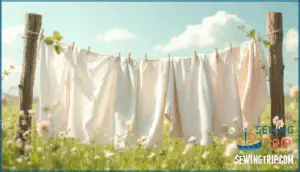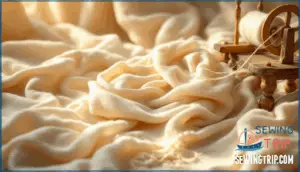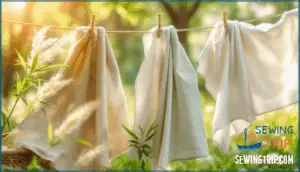This site is supported by our readers. We may earn a commission, at no cost to you, if you purchase through links.

These microscopic details determine whether a fabric becomes your favorite worn-soft t-shirt or an itchy sweater banished to the back of your closet. Understanding what makes fabrics soft—from natural fibers like bamboo to engineered microfibers—helps you choose materials that feel luxurious against your skin and stand up to years of washing.
Table Of Contents
Key Takeaways
- Fabric softness comes down to measurable science—fiber diameter under 3 microns, longer staple lengths in natural fibers, and low friction coefficients create the luxurious feel you’re after, not just subjective preference.
- Natural options like silk, cashmere, and high-quality cotton variants lead in softness, but semi-synthetic fabrics like modal and synthetic microfibers can match or exceed natural softness through precise engineering of fiber structure.
- Your care routine determines whether fabrics stay soft—cold water washing, gentle detergents, low-heat drying, and natural softeners like white vinegar preserve fiber integrity far better than harsh chemicals or high temperatures.
- Post-processing techniques transform ordinary fabric into something exceptional, with enzyme treatments boosting cotton softness by 22% and silicone finishes increasing perceived softness by 15-20% through reduced surface friction.
What Are The Softest Fabrics?
When you’re shopping for soft fabrics, you’ll find they fall into three main categories: natural, semi-synthetic, and synthetic. Each group offers different textures and benefits based on how the fibers are sourced and processed.
Let’s break down the softest options in each category so you can find exactly what feels right for your needs.
Softest Natural Fabrics
When you’re chasing that cloud-soft feeling against your skin, natural fibers often deliver textures that synthetics can’t quite replicate. Here’s what stands out:
- Silk offers peerless smoothness thanks to its long, fine fibers and unique protein structure
- Organic cotton becomes incredibly soft through gentle weaving and eco-friendly processing
- Bamboo textiles combine silky drape with breathability, rivaling cashmere’s gentleness
These natural fiber blends prove softness and texture don’t require chemical shortcuts.
Softest Semi-Synthetic Fabrics
Semi-synthetic fabrics split the difference—they start with natural raw materials like wood pulp but transform them through processing to create textures that rival or even surpass what grows in nature. These semi-synthetic fiber fabrics prove you don’t need purely natural or fully synthetic routes to achieve luxurious soft fabrics.
Modal fabric leads the pack with its beech-tree origins, producing a silk-like drape that breathes better than viscose. Rayon blends offer similar softness at friendlier price points, while bamboo textiles in their semi-synthetic form deliver microfiber-level smoothness without petroleum.
Softest Synthetic Fabrics
Fully synthetic fabrics engineered from petrochemicals can feel just as plush as their natural cousins—sometimes even softer—thanks to precise control over fiber diameter and surface finish. Microfiber polyester leads with ultrafine strands that create velvety smoothness, while synthetic blends combine moisture-wicking properties with fabric softness that resists pilling. Fabric finishing and softening treatments boost synthetic fibers further, making polyester innovations serious contenders in soft fabric types.
- Microfiber durability keeps your favorite pieces feeling fresh wash after wash
- Synthetic blends adapt to your body’s needs throughout the day
- Fabric finishing transforms ordinary polyester into something you’ll reach for first
Key Factors That Affect Fabric Softness
You’ve probably noticed that some fabrics feel like a cloud while others feel like sandpaper. That difference comes down to a few key factors working behind the scenes.
Let’s look at what makes fabric genuinely soft to the touch.
Fiber Type and Quality
Think of fiber fineness as your foundation for softness. When fibers measure below 3 microns, you’ll feel noticeably softer fabric. Natural fibers with longer staple length—cotton over 28 mm, for instance—deliver 12% more perceived softness.
Surface smoothness matters too; silk’s low friction coefficient (below 0.35) creates that luxurious glide against your skin. Impurity removal in cashmere boosts the softness index by 20%.
The fiber properties and fabric construction work together—finer content, smoother surfaces, and purer natural fibers consistently win in softness tests. Understanding fabric softness factors is essential for selecting the softest fabrics.
Yarn Structure and Thickness
Finer yarns—those above 60 Ne—boost softness by 15% compared to coarser options. Single-ply yarns feel softer than multi-ply, and lower yarn twist (below 3.5) increases softness by 17%.
Bulkier yarns with more air content amplify that plush sensation, while yarn evenness smooths out surface irregularities.
These yarn structure details shape fabric construction and directly influence how soft your textiles feel against your skin.
Weave and Knit Patterns
Knit structures like jersey feel 18% softer than woven fabrics of equal weight. Fabric density matters: open-structure textiles score 13% higher on softness indices, while twill weaves and complex jacquard knits show modest softness reductions compared to simpler knitted fabrics.
Loose weave patterns—muslin and gauze—boost perceived softness by 25% over tight weaves.
Sateen weaves with floating yarns on the surface deliver 20% higher smoothness than plain weaves.
Finishing and Post-Processing Techniques
Post-processing techniques can transform fabric softness dramatically. Textile enhancement starts at the mill, where surface treatment options reshape your tactile experience. Finishing techniques reduce friction and smooth fibers, turning ordinary cloth into something you’ll want to touch repeatedly.
Here’s how fabric softening works in production:
- Cationic surfactants slash surface friction by 28%, delivering measurable softness gains
- Mechanical smoothing (calendering) boosts softness ratings 10–12% by reducing roughness
- Enzyme finishes cut fibrillation—cellulase-treated cotton scores 22% softer than untreated
- Silicone treatments lubricate fiber surfaces, increasing perceived softness 15–20%
Even moisture matters: cotton with 8% residual moisture feels 9% softer than fully dried samples.
Softest Natural Fabrics Explained
Natural fabrics have earned their reputation for softness through centuries of use and refinement. You’ll find that materials like silk, cashmere, cotton, bamboo, and linen each bring their own unique texture and feel to the table.
Let’s break down what makes each of these natural fibers stand out.
Silk and Its Luxurious Texture
Silk fabric stands out for its outstanding softness because of its unique fiber composition—primarily fibroin protein with a diameter between 10 and 13 micrometers, finer than cotton or wool. This luxury fabric naturally regulates moisture at about 10%, keeping you comfortable.
In softness analysis, satin weaves deliver the smoothest texture due to reduced friction, while textile innovation continues advancing silk production methods to improve both durability and that signature silky feel against your skin.
The softness of silk fabric is also comparable to other natural fiber types, which are known for their breathability and comfort.
Cashmere and Other Soft Wools
Cashmere production yields exceptionally soft wool fiber because of its fine diameter—usually 14 to 19 microns—making it gentle against your skin. Textile innovation and eco-friendly practices are reshaping this luxury fabric’s market as demand grows for comfort without compromising ethics.
Top soft wools you’ll love:
- Cashmere from goat undercoats offers peerless softness and warmth.
- Ultrafine Merino wool (11–15 microns) rivals cashmere in gentleness.
- Vicuña delivers the softest natural fiber at just 12 microns.
Softness factors like micron count directly impact weaving quality and overall comfort.
High-Quality Cotton Variants
Not all cotton feels the same—thread count and fiber length separate everyday sheets from the buttery-soft variants you’ll want to wrap yourself in. Egyptian cotton and Pima cotton deliver longer fibers (over 1.4 inches), creating smooth, durable soft sheets. Supima cotton tops the chart with extra-long staples, while organic cotton offers gentleness without chemicals. Cotton weaving techniques and higher cotton thread count heighten that luxurious feel you’re after.
Not all cotton feels the same—thread count and fiber length turn ordinary sheets into buttery-soft luxury worth wrapping yourself in
Bamboo and Linen Softness
Bamboo and linen might surprise you—they start off crisp but soften beautifully with wear and washing, offering breathable comfort that actually improves over time.
Bamboo fabric delivers moisture-wicking properties and eco-friendly sustainability, while linen weave creates natural breathability that keeps you cool.
Both soft fabrics prove sustainable textiles don’t sacrifice comfort—you’re getting fabric softness that evolves with each wash.
Softest Semi-Synthetic and Synthetic Fabrics
Not all soft fabrics come straight from nature—science has created some seriously comfortable alternatives. Semi-synthetic and synthetic materials use clever engineering to mimic or even surpass natural softness.
Let’s look at the manufactured options that deliver outstanding comfort without breaking the bank.
Modal and Rayon Features
Modal and Rayon offer impressive softness through semi-synthetic modal production processes that transform natural cellulose into silky fibers. Modal usually feels smoother than rayon due to tighter fiber alignment during weaving. Here’s what sets them apart:
- Modal: Derived from beech trees, it resists shrinkage and maintains fabric softness through multiple washes
- Rayon: Made from various wood pulps, creating varied rayon textures from silky to cotton-like depending on fabric blending
- Softness Testing: Both score high on tactile comfort, with Modal often ranking closer to silk than standard microfiber
Microfiber and Polyester Softness
Synthetic fibers like microfiber and polyester don’t come from plants or animals, but they’ve gotten surprisingly good at mimicking the soft touch you’d expect from natural materials. Microfiber durability stands out because ultra-fine fibers create dense, plush surfaces. Polyester blends often add moisture-wicking properties through specialized fabric finishing techniques.
| Feature | Microfiber | Polyester Blends |
|---|---|---|
| Fiber Diameter | 0.3-1.0 denier | 1.0-3.0 denier |
| Softness Testing | High tactile score | Moderate to high |
| Moisture Wicking | Excellent | Good with treatments |
| Durability | Very high | High |
| Synthetic Textures | Suede-like to silky | Cotton-like to smooth |
Fabric softness improves when manufacturers brush or sand-wash synthetic fibers after weaving.
Sateen and Blended Fabrics
Blending different fibers creates fabrics that balance the best traits of each material, and sateen weaves prove you can turn everyday cotton into something that feels almost as smooth as silk.
Cotton mixtures with microfiber boost fabric softness while adding durability. Thread count matters—sateen weave structures with 300+ threads per inch deliver that lustrous, buttery feel you want in soft sheets.
Fabric blending and softness testing guarantee consistent quality.
How to Maintain and Soften Soft Fabrics
Your softest fabrics won’t stay soft forever without proper care. The way you wash, dry, and store them makes the difference between luxurious softness and stiff, worn-out fibers.
Here’s how to keep your fabrics feeling as good as the day you bought them.
Washing and Drying Best Practices
Your washing routine can make or break the softness you paid for—gentle care preserves those delicate fibers while harsh treatment turns silk into sandpaper. Here’s what actually works:
- Cold water washing protects fiber structure and prevents shrinkage
- Gentle detergents clean without stripping natural softness
- Low heat drying or air-drying maintains fabric integrity
- Hand washing techniques offer supreme control for delicate materials
- Skip harsh cycles that stress weaving patterns and compromise fabric maintenance
Fabric Softening Techniques
Even fabrics that start out buttery-soft can stiffen over time—but a few simple tricks bring back that luxurious feel without a trip to the dry cleaner.
Add white vinegar during rinse cycles for natural fiber relaxation, or use baking soda in gentle washing to strip buildup.
Fabric conditioning with wool dryer balls beats chemical softening agents while maintaining textile finishing quality.
These softening fabrics methods restore that coveted fabric softness you’re after.
Storage and Handling Tips
Proper storage keeps soft fabrics from losing their plush texture between uses—think loose folds instead of tight compression, breathable containers over plastic bins. Folded storage with fabric wrapping protects delicate fibers from moisture damage.
Hanging methods work better for silk and modal, while climate control prevents mildew in humid spaces.
These storage methods are essential for fabric maintenance and softening, guaranteeing your textiles stay luxurious.
Best Uses for Soft Fabrics
Soft fabrics aren’t just about comfort—they’re about creating the right feel for different parts of your life. From the bedroom to your favorite couch, choosing the right soft material makes all the difference.
Let’s look at where these fabrics work best and why they matter in each space.
Bedding and Sheets
The sheets you sleep under can transform a restless night into the kind of deep, restorative sleep that makes mornings feel like a gift. Cotton sateen with high thread count delivers that hotel-luxury softness, while microfiber offers budget-friendly smoothness. Supima cotton and fabric blends balance durability with sleep comfort:
- Sateen weave creates a silky bedding texture
- High thread count amplifies sheet materials’ softness
- Supima cotton provides long-lasting soft sheets
- Fabric blends combine strength with comfort
Clothing and Loungewear
Nothing beats slipping into modal loungewear after a long day—it’s like wrapping yourself in a cloud that actually breathes. Cashmere sweaters and silk fabric robes offer peerless luxury fabrics for softness, while bamboo t-shirts deliver wearable textures with impressive fabric durability.
Soft loungewear isn’t just about comfort—it’s about choosing materials that make you feel good every time you wear them.
| Fabric | Clothing Comfort | Garment Care |
|---|---|---|
| Modal | Cloud-soft feel | Machine washable |
| Cashmere | Premium warmth | Hand wash only |
| Bamboo | Breathable drape | Low-heat drying |
Home Decor and Upholstery
Velvet drapes and linen slipcovers transform living spaces the same way soft fabrics transform how you feel—turning ordinary rooms into tactile sanctuaries you don’t want to leave. Your fabric choices for upholstery tips matter because natural fiber fabrics like silk throw pillows and cashmere blankets define decor trends through textile softness.
Home textiles with proven fabric softness definition—modal cushion covers or bamboo curtains—create soft furnishings that invite touch while synthetic fiber fabrics offer durability without sacrificing comfort.
Frequently Asked Questions (FAQs)
What is the most comfy fabric?
Fabric comfort comes down to fiber type and weave structure. Silk feels smooth. Cashmere delivers warmth. Cotton breathes naturally. Modal mimics silk texture.
These soft textures and gentle fibers create cozy weaves you’ll love touching.
What fabric is softer than cotton?
Silk, Modal, bamboo, and cashmere rank softer than cotton through Softness Testing. Supima Cotton beats standard cotton varieties. Microfiber blending and Fabric Weaving methods improve texture beyond cotton’s baseline.
Texture Analysis shows silk’s smooth protein structure outperforms cotton’s cellulose fibers.
What is the softest most expensive fabric?
Wonder what sits at the intersection of Luxury Textiles and finest comfort? Vicuña wool claims the title as the softest, most expensive fabric, with fibers finer than cashmere.
Silk and Qiviut follow closely in both softness testing results and price tags, making these High End Fabrics the ideal choice for Luxury Clothing.
What is the soft smooth fabric called?
Soft smooth fabrics go by different names depending on their structure. Sateen features a silky weave, while silk offers natural luxurious smoothness.
Microfiber creates super-fine synthetic softness, and Supima Cotton delivers premium gentle textures through long-staple fibers.
What is the most cost-effective way to make fabric soft?
A penny saved is a penny earned—white vinegar in the rinse cycle works wonders. This eco-friendly choice removes residue, restores fiber properties, and costs pennies per load.
Skip fabric softener for a gentle cycle with cold water, achieving lasting softness without harsh chemicals.
What is the best fabric for people with sensitive skin?
You’ll want natural fibers like cotton, bamboo, or silk for sensitive skin. These gentle textures offer soft breathability and skin-friendly properties. Natural fibers rarely trigger fabric allergies, making them ideal for skin-friendliness and comfort.
What are the best washing practices for soft fabrics?
Treating delicate textiles like heirlooms preserves their touch. Cold water washing with gentle detergents protects fiber structure.
Use the delicate cycle care setting or hand washing techniques for fragile pieces. Skip fabric softener on natural fibers—it coats them.
Air-dry flat to maintain softness.
How can I make my clothing softer?
You can boost fabric softening by skipping harsh detergents and using natural alternatives like vinegar or baking soda. Gentle washing with textile conditioning treatments helps preserve fiber content and properties, while air-drying maintains inherent softness better than high heat.
What are the benefits of using soft fabrics?
Using gentle materials against your
How does fabric weave impact softness perception?
Fabric construction determines how fibers interact with your skin. Looser weaves like sateen create gent
Conclusion
You might think fabric softness is purely subjective—something felt but not measured. The science proves otherwise. Thread diameter, weave tension, and fiber composition create quantifiable differences you can feel with every touch.
When choosing the softest fabrics for your home or wardrobe, you’re selecting materials engineered at the molecular level for comfort. That cashmere throw or bamboo sheet set isn’t just pleasant—it’s physics working in your favor, creating textures that transform everyday moments into tactile luxury worth investing in.
- https://consumer.ftc.gov/articles/bamboo-fabrics
- https://www.testextextile.com/the-science-of-softness-understanding-the-factors-that-make-a-fabric-soft/
- https://www.cottoninc.com/wp-content/uploads/2017/12/ISP-1011-Methods-to-Impart-Softness.pdf
- https://www.sciencedirect.com/topics/materials-science/textile-fiber
- https://pmc.ncbi.nlm.nih.gov/articles/PMC11207990/














